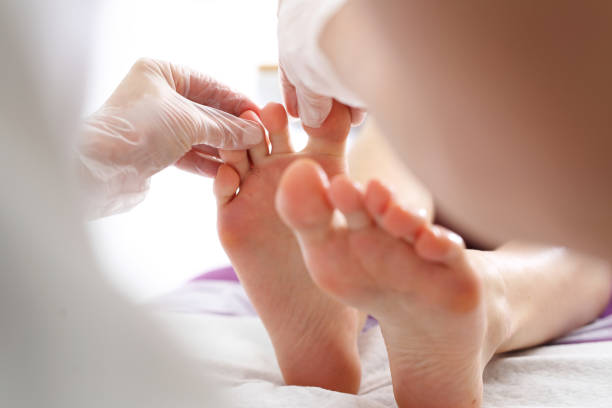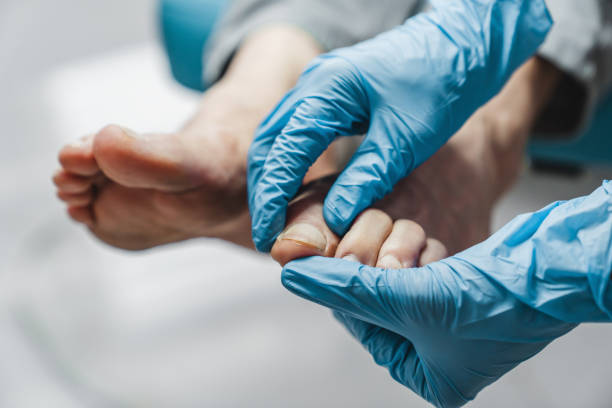The most common cause of ingrown toenails is improper nail trimming. Footwear that crowds the toes and ill-fitting socks can also contribute.
If the ingrown toenail is not infected (red, tender, oozing or foul odor) it may be treated at home. Soaking the toe, cleaning it with antiseptic, using a clean wedge or straight splitter under the edge of the nail and applying antibiotic ointment should improve the problem.

Causes
People with poor foot circulation, diabetes or a weakened immune system are at increased risk of nail problems. If symptoms persist, call a podiatrist in Bendigo VIC to seek advice and treatment as soon as possible..
Ingrown toenails develop when the corners or sides of a toenail dig into or pierce the skin at the side of the nail. This happens most often with the big toenails, but can affect any toenail. Ingrown toenails are often the result of an injury such as stubbing a toe or getting it stepped on, but can also occur due to improper cutting or footwear.
Infections that cause an ingrown toenail can be very painful and require medical care from a . The doctor may place a splint under the toenail to lift it and encourage the nail to grow away from the soft tissue. If the toenail is infected and filled with pus, he or she will drain it. In severe cases, part or all of the nail may need to be removed.
People can prevent ingrown toenails by wearing shoes that fit well and trimming their nails regularly. Soaking the feet in warm water several times a day and gently pushing the skin aside with a cotton ball can also help reduce swelling, pain and inflammation.
Symptoms
An ingrown toenail often occurs when the edge of a fingernail grows into or under the skin adjacent to the nail. This foot condition can cause pain, swelling and redness in the lateral nail fold area. It may also be accompanied by pus formation and infection of the toe or surrounding soft tissue.
In the early stages of an ingrown toenail, a person can usually treat the problem at home without the need for a doctor visit. Soaking the affected toe in a warm saltwater solution several times a day can relieve pain and reduce inflammation and an infection that may develop. To make the solution, add a tablespoon of unscented Epsom salt to a tub of warm water and soak your foot for 15-20 minutes, 3-4 times per day. Make sure to dry your foot thoroughly after each soaking. You can also gently lift the edge of your ingrown nail with a manicure tool and place a piece of cotton or waxed dental floss between the toenail and your skin, changing the cotton each time you soak.
Over-the-counter pain medications, such as acetaminophen or ibuprofen, can help reduce the pain associated with an ingrown toenail. If the infection worsens, a podiatrist may need to drain pus and/or remove the ingrown portion of the nail. This is especially important for individuals with diabetes or other conditions that make healing more difficult.

Treatment
If a minor injury such as an ingrown toenail develops, it should be treated right away. The skin around a nail can become inflamed, warm and swollen with pus or fluid if the problem is left untreated. The infection can also spread to other parts of the body if it gets into the bloodstream. People with diabetes who have poor blood flow to their feet and nerve damage in the toes are especially vulnerable to ingrown toenail infections that can lead to serious complications.
Your doctor may be able to remove some of the ingrown toenail edge by lifting it and placing cotton, dental floss or a splint under the nail. You will need to soak the toe and replace the splint daily. In more severe cases, your doctor may need to drain pus from the infected area or remove part of the nail using a procedure called partial nail avulsion. Your doctor will inject you with an anesthetic before cutting off the ingrown toenail and taking care not to cut the surrounding skin.
Some ingrown toenails might need phenol cauterization to prevent them from recurring. Studies suggest that this is very effective in treating the condition, but it’s not always easy to perform and can be painful. IQWiG health information is written by experts in the field.
Prevention
Ingrown toenails are usually not serious and can be treated at home. Soaking your feet several times a day in warm water with Epsom salt and keeping the area clean can help. If the nail becomes infected, you may need to drain pus and take antibiotics. You may also need to trim the nail, especially if it is curved into the skin.
The best way to prevent ingrown toenails is to cut your nails straight across and not too short, and to avoid having your nails filed by someone who does not know how to do it properly. Wearing shoes that fit properly and avoiding ones that squeeze your toes can also reduce the risk of getting them.
If you develop an ingrown toenail, wedge a small piece of cotton (e.g., part of a cotton ball) under the corner of the nail that is growing into the skin and change it each time you soak your foot. If the pain persists, you should see a podiatrist in Kangaroo Flat.
In some cases, serious or recurring ingrown toenails may require minor office treatment, including partial nail removal (called ablation). Your doctor will inject numbing medicine into your toe and then use a tool to lift the portion of your nail that is growing into your skin. This will prevent it from re-growing into the skin in the future.